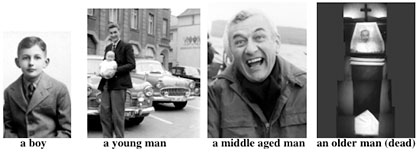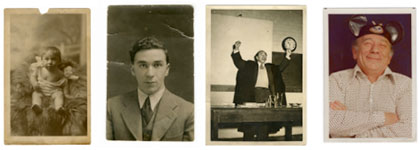The
Book

The
book is available directly from Andrew
Kötting(£30 including postage
and packing UK only). It can also be bought from LUX ONLINE
-------- Book excerpts ---------
So I set
about sending out an invitation to write to 65 invitees, (one for each
year of his life):
-----------------------
INVITATION
This is an invitation to participate in a work provisionally entitled
In the wake of a dad dying
At the bottom
of the page are four photographs of my dad, who is now dead. He was born
on 31st January 1935 and died on 14th December 2000. The first is a photograph
of him as a young boy the second is of him as a man, the third is of him
as a middle-aged man and the last one is of him as an older man, (dead).
I am interested
in trying to compile a portrait of him through the words or marks of other
people. To this end I would be very pleased if you could spare the time
to provide me with “something” about my Deadad. Some of you
will know him, some of you will know about him and some of you will not
know him at all. Some of you won’t even know me. Whilst writing
about my Deadad I would like you to consider a series of questions, (consider
them but disregard them by all means).
Hence some of
the questions might be: What do the pictures tell you about him? What
was his point of view? What did he use to do? What did he want to say
but didn’t? What gave him pleasure? What were his principles? What
was his greatest fear?
Confabulation
is encouraged and there is no prescribed length or size to the work generated.
A pencil is enclosed as a somewhat peppercorn token of my appreciation
for your time and possible energy.
Yours sincerely
Andrew Kötting

-----------------------
I was attempting
to glean a more objective insight into what-who this man might have been
and use some of the replies as an inspiration for my own contemplations
on his-my life and death.
Smidgens
from some of the replies:
….
I think it was the deadgrandad who was a kraut in England at the time
of the war, and some kind of military he was, and as they didn’t
trust the devious köttingkraut, they posted him on the faroes where
he would watch the grey sea for uboats, and, I suppose, wonder what strange
path had led him there, from Deutschland to England to this funny island
with its own language, somewhere farflung in the grey sea, where they
like nuffink better than to tuck into a whale yum yum taste the blubber
on that ….What did he give you, the deadad ? he gave you a name
with an umlaut, which is a major bequest, of which I am most deadenvious.
Wot would I give for an umlaut, to be höpkins..o twould be an marvellous
thing to be sure. For as you know, I know that fing that few brits know,
namely that krautlfings are the best fings around….
Ben Höpkins
…. Erase the human presence and the photographs hold their interest:
(1) A boy’s jacket.
(2) Cars parked outside a European building. (Vehicles, number plates,
heraldic mural, columns of an arcade.) This is not Bexhill, an earlier
life. A young father, angular with potentialities.
(3) A section of boat, a misty jetty.
(4) The cross and coffin.
The story has a clear trajectory, already we know too much of this man,
the dignity of a life in its free-falling predestination. Follow the wavy
line of those elevated eyebrows and a small possession occurs. I don’t
know what happened, but the spirit explodes from the open mouth. The box-boat
slides into an ocean of flame. The man wakes.
Iain Sinclair
….
Your father – full of hope as a child, over sensitive, too much
hurt by the world, and so prone to lashing out, frightening to a child,
I imagine. Terrified of being unloved, and hopeless at making himself
loved. But then all fathers are like this, astonished to find themselves
fathers at all, having to play the role of persecutor when they were born,
like all children, to be the persecuted. And your father my contemporary,
was brought up in a pre-Freudian world, where there were no models for
fatherhood, or any acceptable by a contemporary world.
Fay Weldon
….
I’ve got my nose about an inch from the photographs as I write this.
Wish Andrew had sent clearer ones. A French writer I like, Roland Barthes,
invented the word “punctum” to describe what I’m looking
for in these photos of you. He explain: “A photograph’s punctum
is that accident which pricks me (but also bruises me, is poignant for
me).”
We are getting to the bruising bit, the fact that you who are so alive
or, rather, who is coming alive before my eyes as I look and hear your
voice and type, are no longer alive. That is big time bruising. I can
feel it coming.
Mark Cousins
….
However, in a way, it might be said that Mr Kötting is trying to
be iconoclastic in his approach to his father. He is not trying to discover
the truth about him, the depths of his father’s feelings and emotions,
his relations with his family and friends. He is not even really trying
to come to terms with his own emotions, his own feelings towards his father.
I doubt that he will ever be able to discover his own feelings through
compiling “a portrait through the words or remarks of other people”.
It may, of course, be that Mr Kötting, by inviting answers to his
questions, is attempting to philosophise about the meaning of life in
general and trying to comprehend what it means to be a human being. It
may be that he is trying to surpass his own personal feelings, faults
and limitations in order to see humanity as a whole.
Gregorios
Archbishop of Thyateira and Great Britain

Jem Finer
Seen
through photographs, people become icons of themselves
Portraits in life and death, Susan Sontag


